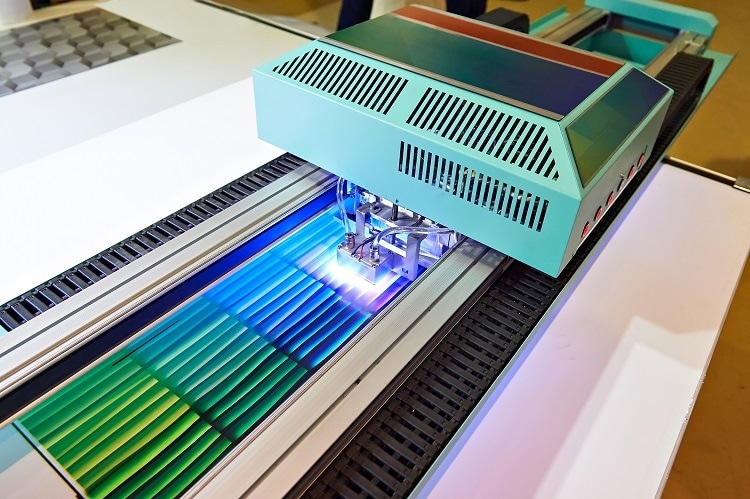
Image Credits: SeregyRzyzhov/shutterstock.com
UV has been used in the printing industry for 30 years, and UV LED printing is transforming operating economics, system capabilities and the environmental effects of printing. While UV and conventional printing use almost the same printing processes, UV LED curing has become a mainstream printing method due to its ability to provide quicker production speeds, less waste, and lower running costs. It also provides a superior overall print quality, as well as being considered a green technology with almost no carbon footprint.
What are the Differences Between UV and Conventional Printing?
The differences between UV and conventional printing are in the types of inks used and the processes used to dry the inks.
Conventional printing uses solvent inks, which have a number of environmental drawbacks. Solvent inks evaporate and release volatile organic compounds, or VOCs, into the air. VOCs can be found in a huge range of consumer products, and are not unique to solvent printing inks. Short-term exposure to VOCs can result in irritation of the eyes and respiratory system and headaches, and long-term exposure can result in damage to the liver, kidneys and central nervous system. Additionally to VOC release, solvent inks can require powders to help the drying process, which further increases conventional printing’s environmental impact, as well as adding time to the overall printing process.
In terms of print quality, solvent inks are absorbed into the paper, meaning the end result can lose vibrancy, and different types of paper can require vastly different drying times. As solvent inks need to be absorbed into the material they are printed on, they can’t be used on materials such as acrylic, plastic, foil, or glass.
In UV printing, inks are dried through photomechanical processes, using light instead of heat. Inks are exposed to UV light during the printing process to be cured immediately. As such, they release no VOCs into the air and print quality is vastly improved as UV inks don’t need to be absorbed by the material they are printed onto.
How Does UV Printing Work?
The UV curing process involves a chemical reaction during which liquid monomers, oligomers and photoinitiators harden when exposed to UV light due to chemical cross linking. In solvent inks, the evaporation meant that the coatings, inks or adhesives applied to the printing material shrank by more than half, decreasing the thickness of the coating and reducing overall quality.
A UV printing system is made up of compartments in which separate colors are applied to the material. Blank printing material is passed through the first compartment of the system, either from a roll or as ready-cut sheets, and from then each compartment prints a color and cures it before the next set of color is applied. The instant curing results in less bleeding or smudging and less rejections or re-prints, again reducing UV curing’s environmental impact.
What is UV Printing Used for?
The range of applications for UV LED printing is extremely vast, making it a very attractive option over traditional printing options. Products that can be enhanced by UV LED printing include:
Bottle Printing
Bottle labelling is a common use of UV LED curing technology, and extends to printing directly onto cylindrical containers.
Medical Labels
UV LED technology has also found its place in the pharmaceutical industry. UV LED is can operate without infrared radiation and in clean room conditions.
Sign Making and Large Format Printing
UV LED curing improves production times and quality for products made in the sign making industry, as well as widening the range of media that can be printed on for this purpose. It is a more economical solution with lower total costs of ownership, and products are more hard-wearing and are less susceptible to fading.
3D Products
UV LED provides smaller machines that can print on heat-sensitive materials. In 3D printing, every layer is cured directly after jetting, which eliminates the need for post-curing. Jewelry, footwear, prototypes, automotive parts and many other products can be made with UV LED curing technology.
UV LED curing can also be used in digital inkjet, flexographic and screen printing processes, among others.
Summary
There are a great number of benefits both to the user and the environment in UV LED curing. UV LED eliminates harmful by-products of printing such as ozone and VOCs, and while UV quartz mercury lights are available for UV printing, UV LED adds additional benefits in eliminating mercury from the process altogether, thus improving safety for users. UV LED also lowers operating costs as it can be turned on and off instantly, meaning the printing unit will only operate when necessary and no cooling times are needed in between uses. UV LED also has a lower power consumption rate and a longer lifetime, meaning it has a vastly lower impact on the environment.
Sources and Further Reading
Disclaimer: The views expressed here are those of the author expressed in their private capacity and do not necessarily represent the views of AZoM.com Limited T/A AZoNetwork the owner and operator of this website. This disclaimer forms part of the Terms and conditions of use of this website.